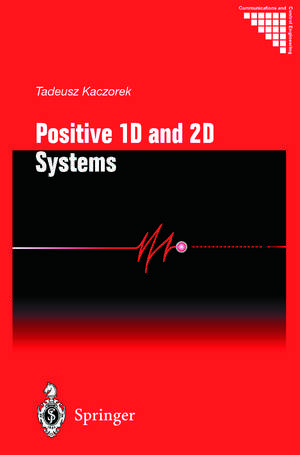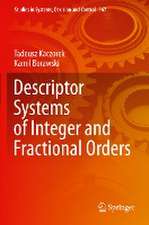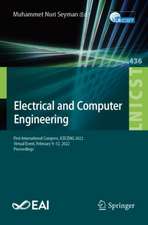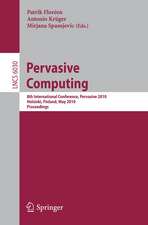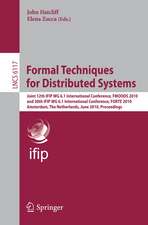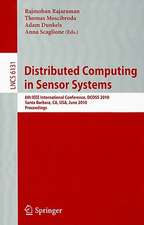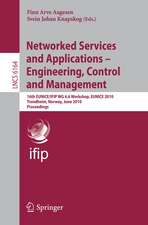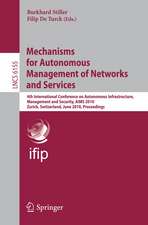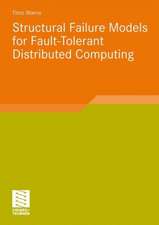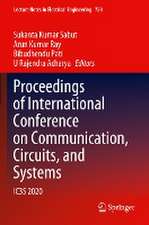Positive 1D and 2D Systems: Communications and Control Engineering
Autor Tadeusz Kaczoreken Limba Engleză Paperback – 23 oct 2012
Din seria Communications and Control Engineering
- 15%
 Preț: 659.70 lei
Preț: 659.70 lei - 20%
 Preț: 879.71 lei
Preț: 879.71 lei - 18%
 Preț: 953.65 lei
Preț: 953.65 lei - 18%
 Preț: 1117.03 lei
Preț: 1117.03 lei - 9%
 Preț: 1385.74 lei
Preț: 1385.74 lei - 18%
 Preț: 1128.08 lei
Preț: 1128.08 lei - 18%
 Preț: 953.65 lei
Preț: 953.65 lei - 15%
 Preț: 656.89 lei
Preț: 656.89 lei - 18%
 Preț: 896.52 lei
Preț: 896.52 lei - 18%
 Preț: 1113.26 lei
Preț: 1113.26 lei - 18%
 Preț: 1388.22 lei
Preț: 1388.22 lei - 15%
 Preț: 647.27 lei
Preț: 647.27 lei - 18%
 Preț: 954.45 lei
Preț: 954.45 lei - 18%
 Preț: 1231.47 lei
Preț: 1231.47 lei - 18%
 Preț: 948.92 lei
Preț: 948.92 lei - 18%
 Preț: 1232.57 lei
Preț: 1232.57 lei - 18%
 Preț: 1127.28 lei
Preț: 1127.28 lei - 15%
 Preț: 643.34 lei
Preț: 643.34 lei - 18%
 Preț: 1401.30 lei
Preț: 1401.30 lei - 15%
 Preț: 651.51 lei
Preț: 651.51 lei - 20%
 Preț: 1454.07 lei
Preț: 1454.07 lei - 18%
 Preț: 948.79 lei
Preț: 948.79 lei - 18%
 Preț: 1233.06 lei
Preț: 1233.06 lei - 18%
 Preț: 947.85 lei
Preț: 947.85 lei - 18%
 Preț: 950.96 lei
Preț: 950.96 lei - 18%
 Preț: 956.99 lei
Preț: 956.99 lei - 15%
 Preț: 644.18 lei
Preț: 644.18 lei - 18%
 Preț: 946.87 lei
Preț: 946.87 lei - 18%
 Preț: 951.14 lei
Preț: 951.14 lei - 18%
 Preț: 961.55 lei
Preț: 961.55 lei - 15%
 Preț: 644.18 lei
Preț: 644.18 lei - 20%
 Preț: 990.80 lei
Preț: 990.80 lei - 18%
 Preț: 1006.72 lei
Preț: 1006.72 lei - 18%
 Preț: 942.44 lei
Preț: 942.44 lei - 18%
 Preț: 1233.06 lei
Preț: 1233.06 lei - 15%
 Preț: 641.85 lei
Preț: 641.85 lei - 18%
 Preț: 957.75 lei
Preț: 957.75 lei - 15%
 Preț: 649.87 lei
Preț: 649.87 lei - 18%
 Preț: 958.07 lei
Preț: 958.07 lei - 18%
 Preț: 1117.99 lei
Preț: 1117.99 lei - 18%
 Preț: 1395.94 lei
Preț: 1395.94 lei - 18%
 Preț: 781.62 lei
Preț: 781.62 lei - 18%
 Preț: 953.20 lei
Preț: 953.20 lei - 18%
 Preț: 1109.78 lei
Preț: 1109.78 lei
Preț: 339.80 lei
Preț vechi: 424.75 lei
-20% Nou
Puncte Express: 510
Preț estimativ în valută:
65.02€ • 68.07$ • 53.80£
65.02€ • 68.07$ • 53.80£
Carte tipărită la comandă
Livrare economică 05-19 aprilie
Preluare comenzi: 021 569.72.76
Specificații
ISBN-13: 9781447110972
ISBN-10: 1447110978
Pagini: 448
Ilustrații: XIII, 431 p.
Dimensiuni: 155 x 235 x 24 mm
Greutate: 0.62 kg
Ediția:Softcover reprint of the original 1st ed. 2002
Editura: SPRINGER LONDON
Colecția Springer
Seria Communications and Control Engineering
Locul publicării:London, United Kingdom
ISBN-10: 1447110978
Pagini: 448
Ilustrații: XIII, 431 p.
Dimensiuni: 155 x 235 x 24 mm
Greutate: 0.62 kg
Ediția:Softcover reprint of the original 1st ed. 2002
Editura: SPRINGER LONDON
Colecția Springer
Seria Communications and Control Engineering
Locul publicării:London, United Kingdom
Public țintă
ResearchCuprins
1. Positive matrices and graphs.- 1.1 Generalised permutation matrix, nonnegative matrix, positive and strictly positive matrices.- 1.2 Reducible and irreducible matrices.- 1.3 The Collatz — Wielandt function.- 1.4 Maximum eigenvalue of a nonnegative matrix.- 1.5 Bounds on the maximal eigenvalue and eigenvector of a positive matrix.- 1.6 Dominating positive matrices of complex matrices.- 1.7 Oscillatory and primitive matrices.- 1.8 The canonical Frobenius form of a cyclic matrix.- 1.9 Metzler matrix.- 1.10 M-matrices.- 1.11 Totally nonnegative (positive) matrices.- 1.12 Graphs of positive systems.- 1.13 Graphs of reducible, irreducible, cyclic and primitive systems.- Problems.- References.- 2. Continuous-ime and discrete-ime positive systems.- 2.1 Externally positive systems.- 2.2 Internally positive systemst.- 2.3 Compartmental systems.- 2.4 Stability of positive systems.- 2.5 Input-output stability.- 2.6 Weakly positive systems.- 2.7 Componentwise asymptotic stability and exponental stability of positive systems.- 2.8 Externally and internally positive singular systems.- 2.9 Composite positive linear systems.- 2.10 Eigenvalue assignment problem for positive linear systems.- Problems.- References.- 3. Reachability, controllability and observability of positive systems.- 3.1 discrete-time systems.- 3.2 continuous-time systems.- 3.3 Controllability of positive systems.- 3.4 Minimum energy control of positive systems.- 3.5 Reachability and controllability of weakly positive systems with state feedbacks.- 3.6 Observability of discrete-time positive systems.- 3.7 Reachability and controllability of weakly positive systems.- Problems.- References.- 4. Realisation problem of positive 1D systems.- 4.1 Basic notions and formulation of realisation problem.- 4.2 Existence andcomputation of positive realisations.- 4.3 Existence and computation of positive realisations of multi-input multi-output systems.- 4.4 Existence and computation of positive realisations of weakly positive multi-input multi-output systems.- 4.5 Positive realisations in canonical forms of singular linear.- Problems.- References.- 5. 2D models of positive linear systems.- 5.1 Internally positive Roesser model.- 5.2 Externally positive Roesser model.- 5.3 Internally positive general model.- 5.4 Externally positive general model.- 5.5 Positive Fornasini-Marchesini models and relationships between models.- 5.6 Positive models of continuous-discrete systems.- 5.7 Positive generalised Roesser model.- Problems.- References.- 6 Controllability and minimum energy control of positive 2D systems.- 6.1 Reachability, controllability and observability of positive Roesser model.- 6.2 Reachability, controllability and observability of the positive general model.- 6.3 Minimum energy control of positive 2D systems.- 6.4 Reachability and minimum energy control of positive 2D continuous-discrete systems.- Problems.- References.- 7. Realisation problem for positive 2D systems.- 7.1 Formulation of realisation problem for positive Roesser model.- 7.2 Existence of positive realisations.- 7.3 Positive realisations in canonical form of the Roesser model.- 7.4 Determination of the positive Roesser model by the use of state variables diagram.- 7.5 Determination of a positive 2D general model for a given transfer matrix.- 7.6 Positive realisation problem for singular 2D Roesser model.- 7.7 Concluding remarks and open problems.- Problems.- References.- Appendix A Oeterminantal Sylvester equality.- Appendix B Computation of fundamental matrices of linear systems.- Appendix C Solutions of 20 linear discrete models.- Appendix D Transformations of matrices to their canonical forms and lemmas for 1D singular systems.
Caracteristici
Will give the reader tools for dealing with uncertainty in control systems which are more advanced and flexible than either traditional optimal control or robust control. Reduces the computational cost of high-quality control and the complexity of the algorithms involved making similar results achievable with less effort by the user.
